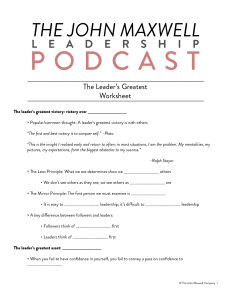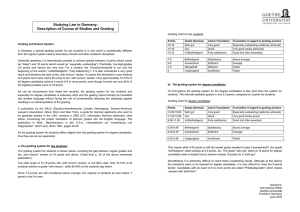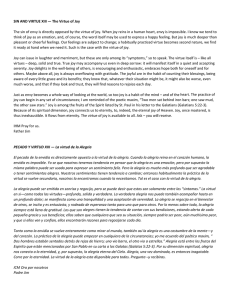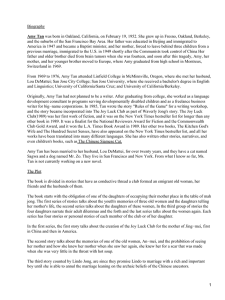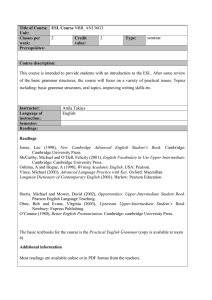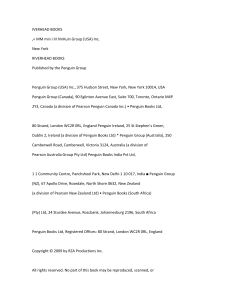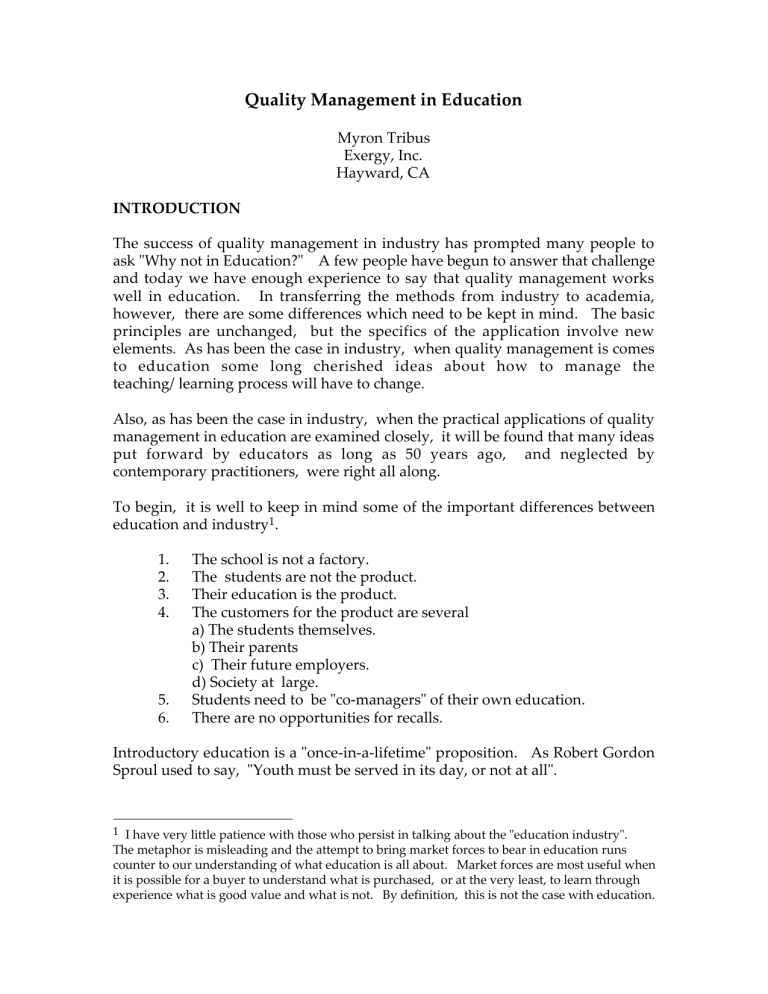
Quality Management in Education Myron Tribus Exergy, Inc. Hayward, CA INTRODUCTION The success of quality management in industry has prompted many people to ask "Why not in Education?" A few people have begun to answer that challenge and today we have enough experience to say that quality management works well in education. In transferring the methods from industry to academia, however, there are some differences which need to be kept in mind. The basic principles are unchanged, but the specifics of the application involve new elements. As has been the case in industry, when quality management is comes to education some long cherished ideas about how to manage the teaching/learning process will have to change. Also, as has been the case in industry, when the practical applications of quality management in education are examined closely, it will be found that many ideas put forward by educators as long as 50 years ago, and neglected by contemporary practitioners, were right all along. To begin, it is well to keep in mind some of the important differences between education and industry1. 1. 2. 3. 4. 5. 6. The school is not a factory. The students are not the product. Their education is the product. The customers for the product are several a) The students themselves. b) Their parents c) Their future employers. d) Society at large. Students need to be "co-managers" of their own education. There are no opportunities for recalls. Introductory education is a "once-in-a-lifetime" proposition. As Robert Gordon Sproul used to say, "Youth must be served in its day, or not at all". 1 I have very little patience with those who persist in talking about the "education industry". The metaphor is misleading and the attempt to bring market forces to bear in education runs counter to our understanding of what education is all about. Market forces are most useful when it is possible for a buyer to understand what is purchased, or at the very least, to learn through experience what is good value and what is not. By definition, this is not the case with education. Quality Management in Education 2 But despite these differences, when properly adapted, our experiences to date show that quality management can make as great a difference in education as it has in industry. Education can be improved, productivity of teachers enhanced, teachers and students find greater joy in their work and the leaving students are more likely to make positive contributions to their society. WHAT IS QUALITY MANAGEMENT? Quality management is a different way to organize the efforts of people. The objective is to harmonize their efforts in such a way that not only do people approach their assigned tasks with enthusiasm, but they also participate in the improvement of how the work gets done. Quality management introduces a significant change in the relationship between those who manage and those who actually do the work. In conventional methods of management, management is looked upon as a privilege and labor is often treated as a commodity. The separation of managers and workers is now so great, it often results in a social distance which breeds discord and contempt. Current methods of management education encourage people to enter management without actually experiencing "life in the trenches", with the result that they not only do not understand what happens there but have little empathy for the people who must cope with the problems that arise when systems and procedures are simply inadequate to the reality of the marketplace. Ed Baker, of the Ford Motor Company, has prepared a table, shown on the next page, which lists some of the more important differences between conventional management and quality management. Quality Management in Education 3 Ed Baker's Contrast between Traditional Style and Quality Management 2 TRADITIONAL MANAGEMENT Enterprise viewed as collection of separate, highly specialized individual performers and units, linked within a functional hierarchy. Lateral connections are made by intermediaries close to the top of the provinces. People are viewed as though a "commodity", interchangeable, and developed based on the perceived needs of the enterprise. People are passive contributors, with little autonomy, doing what they are told and nothing more. Quality is defined as adherence to internal specifications and standards. Quality, therefore, is measured only by the absence of defects. Inspection of people's work by others is needed to control defects. Innovation is not required. The functional provinces are in a zero sum game where there must be a loser for every winner. People cannot be expected to cooperate unless it serves their own or their unit's best interests. Parochialism is a fact of business life. Quality embodies knowledge applicable only to manufacturing and engineering. QUALITY MANAGEMENT Enterprise viewed as a system of interdependent processes, linked laterally, over time, through a network of collaborating (internal and external) suppliers and customers. Processes are connected to the enterprise's mission and purpose, through a hierarchy of micro to macro processes. Every process (core process) contains subprocesses (micro processes) and is also contained within a higher order (macro or supra) process. This structure of processes is repeated throughout the hierarchy. People are the enterprise's true competitive edge. Leadership provides people with opportunities for personal growth and development. People are able to take joy and pride through learning and accomplishment, and the capability of the enterprise to succeed is enhanced. People are active contributors, valued for their creativity and intelligence. Every person is a process manager, presiding over the transformation of inputs to outputs of greater value to the enterprise and to the ultimate customer. Quality is defined in a positive sense as products and services beyond present needs and expectations of customers. Innovation is required. Self-interest and the greater good are served simultaneously by serving one's customers. Everyone wins or no one wins. To quote Dr. Deming, "Business is not a game" Quality embodies knowledge applicable to all the disciplines of the enterprise. 2 Baker has more to say on the subject. The above extract from his paper should give the flavor of quality management compared to traditional management. See: Baker, Ed. " The Chief Executive Officer's Role in Total Quality: Preparing the Enterprise for Leadership in the New Economic Age", Proceedings of the William G. Hunter Conference on Quality, Madison, Wisconsin, 1989, available from Madison Area Quality Improvement Network, MAQIN, 1010 Mound Street, Madison, WI 53715 Quality Management in Education 4 Traditional Management Quality Management Managers manage departments or functions or collections of individuals. The pieces do not know they are interdependent. They each act as if they were the whole. Problems are the result of individual people or departments not doing their best. Managers manage interdependent systems and processes and exercise managerial leadership through participative management in carrying out their roles as mentors, facilitators, innovators, etc. Quality results from the enterprises' systems. People working in the system cannot do better than the system allows. The vast majority of problems will be prevented and improvement will be promoted when people understand where they fit in and have the knowledge to maximize the contribution to the whole. Only management can create the environment that nurtures a team oriented culture that can prevent problems and continually improve Reward systems recognize individual as well as team contributions and reinforce cooperation. Performance appraisal, recognition and reward systems place people in an internally competitive environment. Individualism is reinforced to the detriment of teamwork. Once the organization has found a formula for success, it keeps following it. Management's job, therefore, is to prevent change; to maintain the status quo. The adversarial relationship between union and management is inevitable. The only area for negotiation is in the traditional areas such as wages, health and safety. The environment in which the enterprise interacts is changing. If the enterprise continues to do what it has done in the past, its future performance, relative to the competition, will deteriorate. Management's job, therefore, is to provide the leadership for continual improvement and innovation in processes and systems, products and services. External change is inevitable, but a favorable future can be shaped. The union is a partner and a stakeholder in the success of the enterprise. The areas for partnership and collaboration are broad, particularly in education, training and meaningful involvement of employees in the improvement of the processes which they affect and which affect their work. Hierarchical "chimney" organization structures Formal and informal mechanisms encourage promote identification with functions and tend and facilitate teamwork and team to create competition, conflict and adversarial development across the entire enterprise. relations between functions. Suppliers are to be pitted against each other to Suppliers are partners with their customers. get the lowest price. The more suppliers The aim of the partnership is innovation, competing against each other the better it is for reduction in variation of critical characteristics, the customer company. lower costs, better quality. The aim may be enhanced by reducing the number of suppliers and establishing long term relationships Quality Management in Education Traditional Management Control is achieved by pre-established inflexible responsive patterns given in the "book" of rules and procedures. People are customers of the "book" which prescribes appropriate behaviors Customers are outside of the enterprise and within the domain of marketing and sales. The manager's job is to do the subordinates' planning, and inspect the work to make sure the plans are followed. Motivation is achieved by aversive control. People are motivated to do what they do in order to avoid failure and punishment, rather than contribute something of value to the enterprise. People are afraid to do anything that would displease the boss or not be in compliance with company regulations. The system makes people feel like losers. Competition is inevitable and inherent in human nature. 5 Quality Management Control is achieved by enterprise shared values and beliefs, knowledge of mission, purpose and customer requirements. Everyone inside the enterprise is a customer of an internal or external supplier. Marketing concepts and tools can be used to assess internal customer needs and communicate internal supplier capabilities. The manager's job is to manage his or her own process and relationships with others and give subordinates the capability to do the same. To quote the title of Dr. Aaron Beck's book, Love is not Enough. Managers provide leadership rather than overt intervention in the processes of their subordinates, who are viewed as process managers rather than functional specialists. People are motivated to make meaningful contributions to what they believe is an important and noble cause, of value to the enterprise and society. The system enables people to feel like winners. Competitive behavior -- one person against another or one group against another -- is not a natural state. The competition can be against the environment, or to please the customer, or to eliminate waste of non renewable resources, or to prevent passing on to future generations a damaged planet, incapable of sustaining human life. THE APPLICATION IN ACADEMIA The following principles have been taken from the teachings of W. Edwards Deming and adapted to education. They are numbered for convenience.3 Quality Principle #1: The redefinition of what it means to be a manager. The people work IN a system. The job of a manager is to work ON the system, to improve it, continuously, with their help. 3 These principles are listed differently in a number of my publications. Do not pay too much attention to the numbering. Depending on the audience, I give them different numbers!! Quality Management in Education 6 In translating the redefinition of management to education, we redefine the jobs of the administrators (i.e., the superintendents, the principals and department heads) as follows: The teachers work IN a system. The job of the Principal (Superintendent, Department Head) is to work ON the system, to improve it, continuously, with their help. The jobs of the teachers are also redefined: The students study and learn IN a system. The job of the teacher is to work ON the system, to improve it, continuously, with their help. To make these principles meaningful, it is important to give operational definitions to the various concepts used in them. There are a number of key words used in the definitions, the most important of which is the word "improve". When we say improve, we mean "improve the quality". Therefore, we require a working definition of quality. In industry quality is usefully defined in the following way: QUALITY is what makes it possible for your customer to have a love affair with your product or service. It is possible to produce a temporary infatuation by telling little lies about the product or service, by lowering the price or by adding clever little features, but these will not last. It takes quality experiences to sustain devotion. LOVE is fickle. It is necessary to remain close to the person whose loyalty you wish to retain and to be ever on the alert for changes in desires. The wooing of the customer is never done. In education, this definition is changed. QUALITY in education is what makes learning a pleasure and a joy. Some measures of student performance may be increased by threats, by competitions for grades or by prizes, but the attachment to learning will be unhealthy. It takes a quality experience to create an independent learner. Quality Management in Education 7 JOY is ever changing. What is thrilling at one age is infantile at another. Teachers must be ever alert to engage the students in a discussion of what constitutes a quality experience. The negotiations and discussions are never done. It takes constant engagement to wed a student to learning. Another key phrase in the definition is "constant improvement". In conventional management the rule is "Don't rock the boat" and "If it ain't broke, don't fix it." Teachers are well aware of their problems as they struggle with the inadequacies of the system. Most school systems range from indifferent to hostile to suggestions from the staff regarding improvements which might be made in the system. Quite often the issue is not money but prestige and power. Under quality management, the objective is to seek to find a better way and to do so continuously. Furthermore, the phrase "with their help" means that the improvements are not just dictated from the top. Instead, everyone in the system is expected, invited and trained to participate in the improvement process. In the language of Stephen Covey, the teachers are not only responsible for continuous improvement, they are helped to become response-able. Quality Principle #2: The Quality First Principle Quality is Never Your Problem. Quality Improvement is the Answer to your Problem. Whatever the problem, begin by asking the question, "What does it mean to solve this problem with quality?" Then proceed to make your decision by putting quality first. From the definition of quality, this principle means finding the customer's definition of quality and using it to guide whatever is undertaken. Therefore, before trying to solve a problem, it is important to ask: "What are we trying to do." "Who is the customer for what is about to be done?" and "What does that customer mean by 'quality' ?" In general you do not learn what a customer means by the word "quality" by just asking. Usually customers do not know. You find out by discussion, negotiation and observations of what it is that gives the customer joy and pleasure. It is useful to distinguish between the concepts of "quality" and "feature". industry we understand these two terms this way: In Quality Management in Education 8 FEATURES are what you put into your product or service to appeal to a particular market segment. Air conditioning in an automobile is a feature. In general, adding features costs money. QUALITY, on the other hand, has to do with the integrity with which the features are delivered. For example, an air conditioner in an automobile might be unreliable, noisy, drafty, difficult to control and hard to repair. In general, increasing quality reduces cost. This fact runs counter to the intuition of most people, but there is ample evidence to support it. In education, it is also important to make a similar distinction. FEATURES in an educational experience are such things as computers in the classroom, modern physics laboratories, extensive offerings in drama, arts, music, sports and excellent facilities. QUALITY has to do with the way the teaching/learning process is carried forward. It is possible to have a high quality education in a one room school house, with few amenities. Of course the students will not be adequately prepared for work in a high-tech industry, but the foundation for life long learning can be laid. There are many well educated people among our grandparents, who often went, as I did, to one room school houses. The quality of any process is defined by the customers of that process. In quality management, the customer is defined as the next person in line. This gives rise to the concept of the internal customer. In the classroom, the students are the customer of the teacher; the person who most directly receives the teaching service. This does not mean that the students are in charge of the process. They do not decide upon the features of the educational system, although they ought to be consulted. They do, however, have a voice in defining quality. The following table shows how the students at Mt. Edgecumbe High School in Sitka, Alaska, defined customer-supplier interfaces. Quality Management in Education 9 CUSTOMER SUPPLIER SERVICES Students Teachers System Management Curriculum Design Counseling Leadership Materials and Equipment Administrators Systems Development and Analysis Materials and Equipment Policy Teachers Parents School Boards Administrators School System Industry4 School System Materials and Equipment Knowledge, Wisdom, Know-How and Character of their children Knowledge, Wisdom, Know-How and Character of graduates. When we say that it is necessary to negotiate with students about what constitutes a quality experience, we do not include a negotiation on the features of their education. That will be determined by their elders, though as the students grow older, they will be given greater latitude with respect to what they decide to study. It is futile, however, to attempt to impose the teacher's ideas of quality on the students. If students are to have joy in learning, it will be because the style in which the teaching/learning process is managed conforms to their ideas about what is joy. I am not proposing that teachers relinquish their responsibility for running the classroom. I am proposing negotiation , not abdication. The teachers have a responsibility to press their side of the argument until what results is a consensus which leads to joyous learning, not just enjoyment without learning. Students do not come to school determined to be frustrated and unhappy in their assignments. The want to do well. But usually they do not know what will give them pleasure. Their definition of a quality experience has to be found through discussion and negotiation. It takes time for a teacher to build up a consensus in a class regarding what constitutes a quality experience. David Langford, a teacher at Mount Edgecumbe High School in Sitka, Alaska, has reported that he has often devoted as much as two weeks to a discussion with his class concerning what it takes for them to have a quality experience. To teachers with conventional experience, this would seem like a terrible waste of time. However, David has reported, and I have seen it myself, by interviewing the students, that once the students understand and accept what it means to do quality work, they learn with such speed and effectiveness, that they more than make up for the time spent in defining a quality experience. 4 The last entry was added by the students in Theresa Hick's class of second graders! Quality Management in Education 10 Deming has spoken often of the need for a manager to establish constancy of purpose. To "establish" does not mean to merely announce. It means to develop a sense of purpose which appeals to all members of the establishment and which provides them with a basis for making decisions and taking actions. The establishment of a lofty purpose must also provide joy in work, it cannot just relate to the shareholders desires for profit. The same idea is true in education. discussion of such questions as: Teachers need to engage students in a Why are you here? What are you trying to do? What does it mean to you to do it well? What does the teacher have to do so you can do it well? How will we know if we are doing it well together? Having established a purpose, it is essential that the teacher stick to it for as long as the class exists. At what age can this process begin? I do not know the lower limit. I was pleasantly surprised to learn that Theresa Hicks, a teacher in Wilmington, Ohio, has used this approach with students in the second grade, and has reported a good response. As a Professor with over 30 years of teaching experience, I used a similar approach with University level students with good results. I must admit, however, that I did not pursue it as effectively as either Langford or Hicks because, at the time, I did not have the benefit of Deming's teachings. Quality Principle #3: The Process over Product Principle If you want to improve the product, put your attention on the process whereby the product is made. In industry the principle tells us to cease using mass inspection as a way of getting good products. By the time the product is made and inspected, it is too late. Making flawed products and then throwing them away or repairing them is wasteful of time, energy, materials and human effort. When you watch the product, you are looking a lagging indicators. Studying and improving the process corresponds to working on leading indicators. Improving the process and keeping it under control means prevention of errors, elimination of waste and improvement of the product. In the classroom, this principle translates to: Quality Management in Education 11 If you want to improve the student's achievements, put your attention on the teaching/learning process and not on the achievements in examinations. The idea behind this principle is not new. I do not know how many educators before me understood the importance of this principle, but there must have been many. An interesting case is that of Lev Vygotskii, born in 1896 in White Russia. Despite the opressiveness of the Communist regime, he was able to establish significant schools before his untimely death in 1937. Here are a few of Vygostskii's ideas: 5 Vygotskii challenged the use of conventional standardized tests to indicate mental potential--Vygotskii differentiated between the two ways in which children acquire concepts at school age: 1. Everyday or spontaneous concepts are those which children learn for themselves out of their own day-to-day experiences. 2. Scientific or taught concepts are those which are passed on to children through the speech of adults. He also described two levels of intellectual development in every developing child: 1. The actual or present level of development, manifest in what the child can do alone, without adult help. 2. The potential level of development, demonstrated by what the child can do in co-operation with an adult, through the medium of good teaching (with maximal, optimal help, guidance, explanation, demonstration, etc.) Vygotskii termed the gap between these two levels the Zone of Next Development. In evaluating and defining potential, therefore, attention should not focus on whether children can solve problems unaided, on the basis of what they already know (as we still do in this country in school attainment tests and standardized intelligence tests) but rather upon this Zone of Next Development. He said "Education must not be oriented towards the yesterday of child development, but towards its tomorrow".6 5 This material has been taken from an unusual publication by the BBC, The Transformers. For copies, write to the BBC, Broadcasting Support Services, addressed to the Transformers, P.O.Box. Box 7, London W3 6XJ (Price £2.95) (1990) 6 The work of L. S . Vygotskii has been almost unknown to educationalist in the West until the 1970's. Recent books include Thought and Language, L. S. Vygotskii, translated and edited by Alex Kozulin, MIT Press, 1986, ISBN 0 262 22029 6 Quality Management in Education Applying this principle of quality management to education, inexorably to the following rule: 12 one is led The only legitimate purpose of an examination is to permit the teacher and learner to work together to decide how to improve the educational processes of the student. In other words, for the teacher and learner to decide what to do next. Reuven Feuerstein is an Israeli educator who has applied Vygotskii's ideas in Israel, working with the many traumatized children of the Holocaust. They had this in common: Loss of culture, loss of family, loss of roots, even loss of language. They were so deprived that all conventional intelligence tests suggested that they were beyond the help of education. Feuerstein developed an approach to education which took these backward and seriously disturbed children and adolescents and transformed them emotionally and intellectually so they could take their places in Israeli society. The heart of Feuerstein's approach is to work on improving the processes whereby the children learn. In the case of badly disturbed youngsters, this means persistent intervention in the way the child approaches the learning process. 7 Teachers are required to spend a great deal of time in their own education, studying the learning processes. Unfortunately, the methods of school management, which are so strongly oriented towards testing, tend to create situations in which the teacher's preparation is undermined and rendered ineffective. Quality Principle #4: The Perversity Principle If you try to improve the performance of a system of people, procedures, practices and machines by setting goals and targets for the individual parts of the system, the system will defeat you every time and you will pay a price where you least expect it. There are so many management practices currently in vogue which run counter to this principle. The most pernicious practice among them is "Management by Objectives" or MBO. Under MBO a manager and subordinate agree on what the subordinate is to accomplish and then the subordinate is judged solely on whether the target is met or not. There is nothing wrong with setting targets and objectives as mutual obligations of manager and subordinate. After all, we all 7 More details are given in reference 4, page 29. Quality Management in Education 13 have to know what we are trying to do and when we have to get it done. It is when the manager assumes that the outcomes are entirely the doing of the subordinate and that the manager can abdicate his or her responsibility for the improvement of the system, that the practice becomes so destructive. It is possible to carry over into education the same harmful practices as occur in industry by thoughtlessly adopting a new approach called "Outcome Based Education". Outcome based education contains two parts: The setting of the goals and objectives of education, which is good, and a bad part, the use of outcomes only, as a basis to judge, reward and chastise, portions of the system of education . Unfortunately, this idea has become a cornerstone of President Bush's approach to the improvement of education, as described in "America 2000". EVALUATIONS This discussion naturally leads us to the subject of the grading of children. Deming has long railed against the practice of giving an annual evaluation to all employees. This is one of those practices which have been described by the comic strip character Dagwood Bumpstead, who said, "You know, that makes a lot of sense if you don't think about it." The most logical arguments against the practice of giving annual evaluations have been mustered by Peter Scholtes.8 If the evaluation process is so damaging to adults, think of what it does to children. It is a fact, from mathematics, that in any group of 100 children, 50 of them will be ranked in the bottom half on any test, no matter how well they do. In short, half of each generation is branded "inferior" and, what is worse, believes it for life! If teachers attempt to use the grading system as a means to violate the perversity principle, a price will be paid. There is nothing so destructive of the joy of learning than to be told you are a failure, branded for life. It will take years to wipe out the practice in industry. In my experience it will take even longer to remove the grading system from education. It is easier to move graveyards. WHAT TO DO INSTEAD OF GRADING? Teachers, especially college professors ask me, "What shall we do instead?" The answer may be found from the quality first principle. Let us ask these questions: 1. What are we trying to accomplish through grading? 8 Scholtes, Peter "An Elaboration on Deming's Teachings on Performance Appraisal", pp 24-52 in Performance Appraisal: Perspectives on a Quality Management Approach", Mclean, Damme and Swanson, editors. ASQC Alexandria, VA 1990 Quality Management in Education 14 2. Who are the customers for the solution? 3. What do they think represents a quality solution. There seem to be two obvious answers to the first question. a) We are trying to put the student ond others on notice regarding where he or she stands in relation to the others. In other words, provide an "objective" evaluation. To help people understand how to deal with this question, I usually propose, to the questioners, that we provide an examination to test them. It is surprising (or is it?) how quickly they change their ideas when they are on the receiving end of the grading system. b) We are trying to decide which students should be allowed to go on to higher levels of education, where the social cost of taking on students who fail is high and where the resources for such education are often scarce. (As, for example, in medical schools.) To develop an alternative to testing, we need to turn our attention to a more fundamental issue: What are we trying to do? What are we looking for? WHAT DO WE PROPERLY EXPECT OF OUR SCHOOLS? Raising this question leads us to different questions, more important than the question of grading. The question is, how should a school define its purpose and then stick with it? I shall offer my own solution to this question, but would emphasize that it is up to the local school district to answer it for itself. I maintain that we properly expect the schools to provide education in four categories: 1. KNOWLEDGE which enables us to understand what we learn in relation to what we already know. Knowledge provides us with the ability to generalize from our experiences. With knowledge we can accumulate 30 years experience instead of just one year repeated 30 times. 2. KNOW-HOW, which enables us to do. Know-how takes us past merely understanding. It enables us to put knowledge to work. 3. WISDOM, which is the ability to decide what is important and what is not. Wisdom allows us to set priorities for ourselves. 4. CHARACTER, which, as Stephen Covey has said, is a combination of Knowledge, Know-How and Wisdom, coupled with motivation. We Quality Management in Education 15 recognize the development of character by certain character traits, among which we list: Honesty Truthfulness Ability to work alone Initiative Integrity Ability to work in a group Curiosity Cooperativeness Initiative Self Esteem The list of knowledge which students are expected to acquire, for most schools, is a composite of what is handed down from the central authority (the source of funding or accreditation) and what the school decides to do for itself. The list of know-hows is usually less specific, except for vocational schools. In general the authorities pay no attention to either wisdom or character. On the other hand, when the Secretary of Labor of the USA appointed a commission from industry to say what was wanted of the graduates of our schools, they came up with their own list. They identified five competencies and a three part foundation of skills and personal qualities needed for solid job performance.9 The table on the next page is taken directly from the SCANS report. In general, only the schools at the grade level seem to pay much attention to the development of character. At each higher level the teachers seem to want these elements to have been taken care of by someone else. In a University, only the football coaches seem to worry about the development of character. As for the development of wisdom, many educators, not having developed it themselves, throw up their hands at the thought of teaching it to children. The development of wisdom and character is best handled by having students participate in creative, team activities. In such a setting, they learn to set priorities, to work together and to develop the social skills required in a society where teamwork is essential to success. Under these circumstances the students require a coach more than they require a teacher. 9 What Work Requires of Schools--A SCANS Report for America 2000, The Secretary's Commission on Achieving Necessary Skills, US. Department of Labor, June 1991. Quality Management in Education 16 WORKPLACE KNOW-HOW The know-how identified by SCANS is made up of five competencies and a three-part foundation of skills and personal qualities that are needed for solid job performance. These include: COMPETENCIES--effective workers can productively use: • Resources--allocating time, money, materials, space and staff; • Interpersonal Skills--working on teams, teaching others, serving customers, leading, negotiating, and working well with people from culturally diverse backgrounds; • Information--acquiring and evaluating data, organizing and maintaining files, interpreting and communicating and using computers to process information; • Systems--understanding social, organizational, and technological systems, monitoring and correcting performance, and designing or improving systems; • Technology--selecting equipment and tools, applying technology to specific tasks and maintaining and troubleshooting technologies. THE FOUNDATION--competence requires: • Basic Skills--reading, writing, arithmetic and mathematics, speaking, and listening. • Thinking Skills--thinking creatively, making decisions, solving problems, seeing things in the mind's eye, knowing how to learn, and reasoning. • Personal Qualities--individual responsibility, self-esteem, sociability, self-management and integrity. In Connecticut, where there are several quality management councils actively adapting quality management to schools, a rather complete attempt has been made to identify the elements of knowledge all students should acquire. The goals are expressed without a clear distinction between knowledge and knowhow, but it appears to me that they have made a good start.10 The list is being reviewed and improved by representatives from a broad cross section of the public. There is a difficulty in establishing the goals and objectives of schools because of the rapidity with which changes have been occurring in society at large. Professor Ron J. McBeath, San Jose State College has prepared the table on the next page, which I have found very useful in understanding why people of different ages and at different positions in our society have such different ideas about what our schools should do. 10 Connecticut's Common Core Education, January 1987. of Learning, adopted by the Connecticut State Board of Quality Management in Education 17 Table 1. Three Eras AGRICULTURAL Wheel Manpower Cottage Industry Explore Village CLASSICAL Certainties Absolutes Closed Systems Do Things To Autocratic Teacher Dominated Subject Emphasis Fixed Response Rote Memory Product Oriented Active mind Extrinsic Motive Age Grouping Class Teaching Limited Access Teaching Aids Convergent Thinking Competitive Inner Directed Dependent In Production INDUSTRIAL Motor Machine Power Mechanization Exploit City In Science QUANTUM RELATIVISTIC Confusion Relative Absolutes Open Systems In Education Do Things For Laissez-faire Permissive Method Emphasis Varied Response Free Expression Process Oriented Reactive Mind Extrinsic Motive Standards Grouping Group Teaching Random Access Audiovisual Divergent Thinking Cooperative Other Directed Independent INFORMATION Jet Propulsion Mechatronics Automation Conserve Global Market INFORMATION Probabilities Relatives Organic Systems Do Things With Democratic Inquiry Centered Interdisciplinary Response mastery Creativity Performance Transactive Mind Intrinsic Motivation Readiness Grouping Independent Study Systematic Access Instructional Technology. Right and Left Brain Adventure Self Actualizing Interdependent In general people in responsible positions in our society, which means they are usually older, tend to think of education in terms of the left column. Young teachers are likely to be found in the right column of Professor McBeath's table. Therefore, if there is to be a consensus among those who pay for public education, it is necessary to develop a statement of purpose for the schools, from which there may flow solutions to problems which are acceptable to the greatest number of customers. Quality management gives a greater hope to accomplish this, for through quality management it is easier to bring the "voice of the customer" into the design of the educational experience. Quality Management in Education 18 As teachers and students become familiar with quality management, they are apt to move to a fourth column, which is to the right of the three columns developed by Professor McBeath. The students at Mt. Edgecumbe High School, after considering their own motivations and the way they want to interact with their teachers, have developed the following table. Possible Roles of Teachers and Students Teachers Students DO TO No choice Captive Antagonist DO FOR Captive Passive Dependent DO WITH Dependent Accepting Follower ENABLE Independent investigator Seeker of Knowledge LET ME OUT! I'M OK! IT'S OK JOY IN LEARNING An important feature of the educational process, as we move from left to right in the above table, is the development of increasing autonomy on the part of the student. This is one of the qualities demanded in the SCANS report and which tends to be destroyed by the rigorous application of standardized tests. The perversity principle is valid and those who try to defeat it will fail. Their customers, the students, will suffer. SOME PROBLEMS AND SOLUTIONS IN APPLYING QUALITY MANAGEMENT IN EDUCATION. We close this essay with a few remarks which we hope will be helpful to those who decide to apply quality management in education. Because we have so little experience, anyone who begins today must become a pioneer. It helps to keep in mind that we are dealing with four interactive systems as indicated in figure 1 below. Quality Management in Education 19 THE EDUCATIONAL SYSTEM M TH M ER ANAG IAL SYST M E E TH CIAL SYST SO E E Technical Tools and Techniques Figure 1. The four systems to be considered when introducing quality management into any enterprise, whether in industry or education. The innermost circle is where the work gets done; where the tools and techniques are applied. Quality management has now evolved a number of special tools and techniques which are of great value in the improvement of systems. They are described in many excellent books on quality management, but few have been translated into experiences in education. The work place, however, is within a social system. A teacher cannot introduce a new approach in a classroom if the other teachers object. The approaches to the development of wisdom and character must necessarily involve the entire faculty. Materials taught in one subject impact on what is taught in others. It is not possible to consider only the set of tools and techniques without considering the social system in which the processes are imbedded. Quality Management in Education 20 The social system, in turn, is imbedded in a managerial system. The managerial system, with its practices, protocols, permissions, privileges, and politics determines the nature of the social system. All three of these systems are "boxed in" by the education of the people who inhabit them. It is for this reason that any approach to the introduction of quality management, must begin with education for the staff.11 The leader of the change process will need to devise a strategy. I suggest it will have four important components, at the start. More items will be added later: 1. Development of a general awareness of why it is necessary to change. 2. Establishment of goals and objectives for the change. 3. Understanding, broadly shared, of what the change entails in all three of the systems of figure 1. 4. A sensible set of first steps. Those who would lead the change process should understand some of the dynamics involved in changing people's paradigms. DISCUSSION WITH PEERS ATTITUDE EXPERIENCE INTERVENTION BY A ROLE MODEL ACTION Figure 2. Changing the paradigm of a person. Figure 2, above, indicates how people are locked into a reinforcing circle unless intervention occurs and an opportunity is afforded for reflection. Instead of the Deming-Shewhart circle of "Plan-Do-Study-Act" they are caught in a vicious circle of "Act upon Attitude", "Gain Experience", "Reinforce the Attitude". It requires intervention to break the cycle. 11 In a later paper I intend to provide a list of the special competencies (both knowledge and know-how) teachers and administrators will require for the practice of quality management. Quality Management in Education 21 Corporate Culture Corporate Review and Discussion Intervention by a Manager Corporate Experience Standard Procedures Figure 3. Changing the culture of an enterprise. Fix it Myself Figure 4. Circles of influence. s ue Joi n r Ge !) N eg NTROL OF A HE CO NY T D ON N O E Y E B hange (BRIN GD or C f e t AT ia A ot m o S r u f p erv elp iso tH th Collea Wi g Quality Management in Education 22 As pictured in figure 4, everyone has a circle of influence and everyone must deal with things beyond the control of anyone. Managers should always try to enlarge the circle of influence of subordinates. AN EXAMPLE OF ONE TOOL FOR USE BY TEACHERS AND STUDENTS TO IMPROVE THE TEACHING/LEARNING PROCESS. TEACHING METHOD CONCEPTS Bar Chart Check Sheet Control Chart Control Limits Histogram Loss Functions Pareto Charts Procedures Process Capability Common vs Special Run Chart Scatter Diagram Work Sampling Watch Video Read Text Read References Class Discussion Guest Lecture Homework Project The following method has been adapted from a technique used in industrial quality management (in cooperation with the students at Mt. Edgecumbe High School). The matrix is known as a "Quality Function Deployment Matrix" and shows in the rows the particular topics (either knowledge or know-how) which have been selected for inclusion in the studies. The vertical columns indicate the various educational experiences the teacher has decided to use. At each intersection the students grade, for themselves, the effectiveness of the experience. The teacher indicates the effectiveness rating appropriate for the class as a whole. As a result of the application of this method, over time, the effectiveness of the instruction should rise. Student's evaluation of process 2 3 Teacher's evaluation of process Figure 5. A QFD matrix applied to education. At each intersection, the students and teachers indicate their evaluations of each learning situation. Scores given by the various students are discussed and used as the basis for improvement. Quality Management in Education 23 It is not sufficient to just identify competencies. It is important to define the levels of competency the students are expected to attain. These levels should be defined, jointly with the students, for every area of learning. The following table shows 3 of the seven levels of competence which were developed by the students in Alaska. Similar levels have been described many educators 12 . What is important about the following table is that it was understood and accepted by the students. Based on their internalization of these concepts, the students evolved their own slogan for learning: "If it isn't perfect, it isn't done". Level 1 Level 2 Level 3 Recall: Remembering knowledge Action: Read, view, listen Demonstrate: Tell, name, list, define, Who?, When?, Where? Understanding: Comprehension Action: Explain, vocabulary development, reflect what is said Demonstrate: Give main idea, predict, evaluate cause and effect Problem Solving: Given this, find that Action: Solve text book type problems Demonstration: Solve, prove PROBLEM FORMULATION AS A BARRIER My own education, up through the Ph.D., as I believe it has been with others, has been long on techniques for solving given problems, but short on methods of problem recognition, definition and formulation. When people are to work together, in teams, to improve a process, it is essential that they have methods for defining what the problem is and what constitutes a quality solution. This is far from a trivial task. Under quality management, a number of useful methods have been developed. Simple methods, such as the fishbone diagram, shown below, can be used by groups as a means of taking vague ideas and working them into a list of actions which can be prioritized. Theresa Hicks has shown me fishbone diagrams produced by second graders, in which they analyzed the various causes which might have contributed to their getting homework in too late. 12 For an audience of educators, it is not necessary to go more deeply into the definitions of levels of competency. The important point is that until they are understood by the students, they cannot be used to help students become response-able in their own education. Quality Management in Education 24 Character Wisdom Honest Sense of priority Considerate Know what is worth doing Self-controlled How to get along Logical Thinker Not self destruct without Cooperative cause Proactive Hygiene (including sex) Government History Economics Literature Career choices Psychology Languages Philosophy Science Anthropology Math Knowledge A Graduate of whom to be Proud Reading Writing Arithmetic Problem Solving Computers Know-How (Competence) Figure 6. A fishbone diagram as might be prepared by a curriculum improvement committee. CONCLUDING REMARKS There are many other tools and techniques in quality management which may be found by reading the literature of quality management. I have not touched upon statistical methods, which are extremely important. Nor have I dealt with the various ways in which one may diagnose a system and find potentials for improvement. Future papers will consider examples of how to translate these methods from industry to education. I can think of no other activity which promises more leverage in the improvement of society than the development of a generation which understands quality and is equipped to improve it.



